-
|
|
|
|
|
|
|
|
|
|
|
|
| Construction | Cost in G.P. | Defensive Point Value
<HP.M><finish><check these> |
| Arrow slit | 3 | - |
| Arrow slit, crossletted | 5 | - |
| Barbican | 4,000 | *150 |
| Bartizan, 10' d., 20' h. | 300 | 25 |
| Batter, plinth or splay | 50 | +20** <> |
| Battlement, 14' long | 20 | 12 |
| Building, stone | 500 | 10 (per course) |
| Building, wood | 200 | 8-16 |
| Buttress, stone, 3' w., 5' d., 10' h. | 15 | +20** <> |
| Catwalk, wooden, 10' l. | 10 | - |
| Ditch, 100' l., 10' d., 20' w. | 100 | - |
| Door, iron, 4' w., 7' h. | 100 | 10 |
| Door, secret, 2' w., 4' h. | 50 | <?> |
| Door, trap, 2' w., 3' l. | 2 | <?> |
| Door, wooden, 4' w., 7' h. | 10 | W1 |
| Door, wooden, reinforced, 4' w., 7' h. | 25 | 3 |
| <Doors, double reinforced = Gate> | <?> | 8-12 |
| Drawbridge, 10' w., 15' l. | 400 | 10-15 |
| Embrasure shutters | 3 | - |
| Gatehouse, stone | 2,000 | 120 <see Gate> |
| Hoardings, wooden, 10' l. | 10 | 2 |
| Machiolation, stone, 10' l. | 100 | - |
| Merlon, 4' w., 3' d., 5' h. | 6 | 10 |
| Merlon, pierced with arrow slit, 4' w., 3' d., 5' h. | 10 | 10 |
| Moat, 100' l., 10' d., 20' w. | 250 | - |
| Murder hole | 10 | - |
| Palisade, wooden, 100' l., 10' h. | 100 | 6-12 |
| Parapet, stone, 10' l. | 10 | 20 |
| Pilaster, 5' w., 3' d., 10' h. | 25 | +15** <> |
| Pit, 5' cube | 4 | - |
| Portcullis, 10' w., 15' h. | 500 | 12 |
| Rampart, earth, 100' l., 10' h. | 100 | E40-80 |
| Stairs, stone, 10' rise, 3' w. | 50 | - |
| Stairs, wooden, 10' rise, 3' w. | 10 | - |
| Tower, round, 20' d., 30' h. | 850 | 40-80 |
| Tower, round, 30' d., 30' h. | 1,350 | 40-80 |
| Tower, round, 40' d., 30' h. | 1,600 | 40-80 |
| Tower, square, 10' sq., 30' h. | 600 | 30-50 |
| Tower, square, 20' sq., 30' h. | 900 | 30-50 |
| Tower, square, 30' sq., 30' h. | 1,200 | 30-50 |
| Tunnel, underground, 5' w., 8' h., 10' l. | 100 | - |
| Wall, bastion, 5' w., 20' h., 40' l. | 500 | 40 |
| Wall, curtain, 10' w., 20' h., 100' l. | 100 | 20**** |
| Window, shuttered, 2' w., 4' h. | 7 | 4 |
| Window, shuttered & barred, 2' w., 4' h. | 10 | 12 |
<Mega Hit Points
: formerly, DPV : Defensive Point Values.>
<HP.ME = Mega Earth
HP>
<HP.MW = Mega Wood
HP>
<HP.MS = Mega Soft
Stone HP>
<HP.HR = Mega Hard
Rock HP>
<link to main HP.M explanation>
Arrow
slit: Each
arrow slit assumes a space behind it in which the bowman stands, 1/2" w.,
4" l.
COST: 3
gp
DPV: -
Arrow
slit, crossletted: As the name implies, this is a straight slit with
a cross slit for crossbows.
COST: 5
gp
DPV: -
Barbican:
The barbican is a solid stone outwork with
two 30' diameter by 30'
high round towers and
a connecting building 20'
wide by 30' long by 20' high.
It must be properly pierced
and battlemented.
The barbican can include
a gate or can be a simple outwork.
COST: 4000
gp
DPV: 150 (exluded any values
for gates or portcullis)
<> * 150 MP : Excludes any values for gates or portcullis.
This is a small tower built
to provide flanking fire on curtain walls or as an additional
firing platform.
COST: 300
gp (10' d., 20. h)
DPV: 25
Batter,
plinth or splay: These terms describe a sloping support which <angle?
cf. WSG, slopes>
strengthens wall or tower
bases, hindering attack by machine or humans.
COST: 50
gp
DPV: 20
<> ** +20 MHP : All these defensive points must be destroyed before the construction supports can be affected, i.e., a tower with a batter is valued at 20 additional points.
These are the parapet (or
sill), embrasures, and merlons set
atop a wall to provide cover
for bowmen. If the surface is not broad, a catwalk
(q.v.) must also be constructed.
A 14 ' section of battlement will
typically have two 4' wide
merlons and two embrasures 3' wide.
COST: 20
gp
DPV: 12
This is a single course (1'
thick) of dressed or field stone with 120' of outside walls 20' high,
with two wooden floors (second
and attic),
two flights of stairs,
a peaked roof,
and one wooden
door.
Cellar excavation, ground
flooring, windows, interior walls, and additional doors are extra.
The cost to increase wall
thickness is 10% of initial cost per course of stone (1' thickness).
<[Example]>
Thus, the building upgraded to 10 ' thick walls (and appropriate outer
dimensions) would cost 500 G.P. plus 90%,
or a
total of 950 gold pieces.
The cost of a stone building
can be used for computing interior dungeon walls.
COST: 500 gp
DPV: 10 (per course) (hard
rock)
Nandar
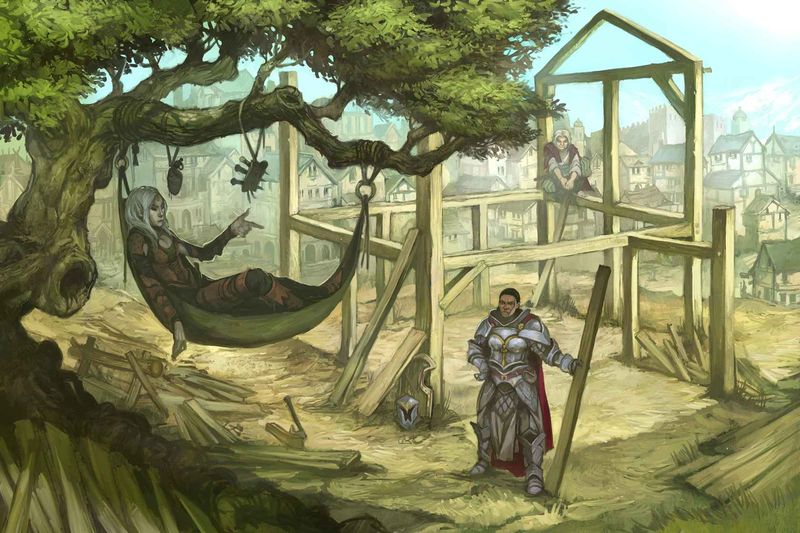
This is the same as stone
building above, but walls are
framed with planks, total
thickness 1/2'.
COST:
200
gp
DPV:
8-16
This
is a wall support generally used for reinforcing the outside surface of
a curtain wall, tower, etc.
To
buttress a wall up to 20' height, the equivalent of three buttress sections
is needed.
<> ** +20 MHP : All these defensive points must be destroyed before the construction supports can be affected, i.e., a tower with a batter is valued at 20 additional points.
DIMENSIONS:
3' w., 5' d., 10' h.
COST:
15 gp
DPV:
+20 (hard rock)
Catwalk:
This is a sturdy platform about 3' wide which is built upon a wall
or palisade to enable defenders
to shoot or fight over the top of the construction.
COST: 10 gp
DPV:
Ditch:
This is a trench excavated as an obstacle, with sloped, compacted, and
sodded sides.
If a rampart
of earth is built immediately above one side of a ditch the cost of the
rampart is only 20% of the amount shown.
The cost of ditching can
be used for computing the cost of excavating for cellars, basements, dungeons,
etc.
COST: 100
DPV:
Door,
iron:
An iron door is typically set into stone with three long hinges/supports.
It
consists of plates about one inch thick bolted to a frame about one-half
that thickness.
The
cost of larger or smaller or thicker doors is 2 g.p./sq. ft. of one-half
inch iron added to or subtracted from the basic door cost.
It
has an iron bar on one side.
COST:
100 gp
DPV:
10
Door,
secret,
2' w., 4' h.:
This is a stone portal which operates by counter-poise
or pivot, with a hidden mechanism to trigger operation.
There is no reduction for
smaller portals, and the cost for larger ones is 5 g.p. per square foot
of increased size.
COST: 50
gp
DPV: <?>
Door,
trap: This
is a stout wooden door about two inches thick set into a floor.
It is raised by an iron
ring which is constructed as part of the trap door.
Each additional square foot
of trap door costs 1 s.p.
COST: 2 gp
DPV:
Door,
wooden: This
is a sturdy door of hardwood (maple, ash, etc.) about three inches thick.
A square foot of additional
wood (or for less wood) in the door is 2 s.p.
The door is barred on one
side by a two-by-four.
COST: 10 gp (4' w., 7' h.)
DPV: 1(W)
Door,
wooden, reinforced:
This is a stout oaken door, four inches thick,
bound with iron
bands and secured by a 3' x 6' oaken bar.
Each square foot of alteration
is valued at 5 s.p.
COST: 25 gp (4' w., 7' h.)
DPV: 3
This is a bridge of six-inch
thick hardwood planks bound with
iron
and attacked to great chains which pass through the wall of the
stronghold. These chains
are used to raise the drawbridge by means of a
winch and capstan bars and
held fast by pawl
&& ratchet.
<>
Each 1 square foot alteration
is valued at 2 g.p.
COST: 400
gp
DPV: 10-15
< Image by Bloated Blowfish >
<Earth
Excavation: The cost of the ditch
100' in length, 10' deep, and 20'
wide assumes that a crew of 3-4 men work for six weeks.
If soil is heavy
clay, time will be doubled.>
DIMENSIONS: 100' l., 10'
d., 20' w.
COST: 100
gp
DPV: -
<>Construction Time (Note)>
Embrasure
shutters: These wooden pieces mask an embrasure. They are
constructed in two sections,
independent of each other, which rest firmly
against the merlons on either
side but swing out from the bottom to allow
archery.
<(see Missile Fire Cover and Concealment Adjustments, DMG)>
COST: 3 gp
DPV:
A gatehouse
is a building of stone with walls 5' thick,
two
reinforced doors guarding a portal 10' wide by 12' high,
a
portcullis,
and
machicolated battlements atop the structure.
It
is 30' high to the battlement;
the
battlement is 7' high.
The
gatehouse has 140' of outer walls.
Two
barbettes cover its gate side. <barbette
needs to be defined>
COST:
2000 gp
DPV:
120 <see Gate>
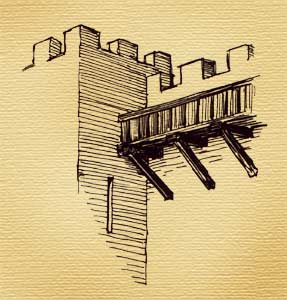
This is a very stout wooden
catwalk projecting in
front of a wall. It has
embrasures, a peaked roof connecting it to the battlement,
and holes in the flooring
to enable defenders to hurl and dischorge
missiles at attackers at
the wall foot.
COST: 10 gp (10' l.)
DPV: 2
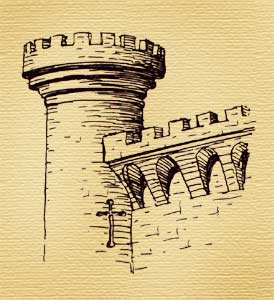
This
is a stone projection which moves the battlement
out
over the outer face of the wall. It has spaces in the stone flooring
which
allow missiles to be discharged to the space at the wall foot.
COST:
100
DPV:
Merlon,
pierced with arrow slit, 4' w., 3' d., 5' h.:
A
stone section rising above the parapet to provide cover for defenders a
top wall or tower is a merlon.
The
merlon can be pierced with a slit for additional missile power.
<(see Missile Fire Cover and Concealment Adjustments, DMG)>
COST:
10
gp
DPV:
10
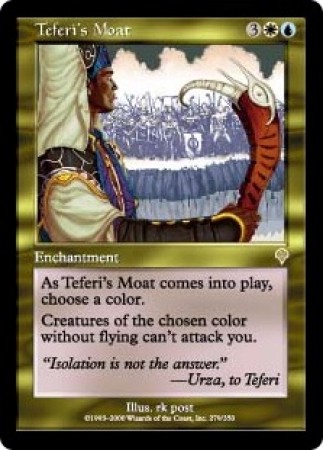
A water-filled
ditch (properly packed and graveled in most cases)
comprises a moat.
COST: 250 gp (100' l., 10'
d., 20' w.)
DPV:
Murder
hole: This is a slit, crossletted slit, or similar opening in a floor
to
command a passageway below.
In combination with inner
portcullis, inner
wall slits, and pits, they
make an entrance possage in a gatehouse or
similar structure very unhealthy
for attackers.
COST: 10 gp
DPV:
Q: What is a murder hole?
A: A murder hole is
an opening in a ceiling,
usually in a fortification,
from which a
defender can attack an intruder
with a
spear or other long, stabbing
weapon. It is
very hard to return an attack
made from a
murder hole. In the D&D
game, a murder
hole provides the attacker
with full cover
(-4 AC bonus). In the AD&D
game, a
murder hole provides 75%
cover (+7
defensive adjustment).
(126.14)

A wooden fence of logs about
six inches thick sunk into the ground from 4' to 6' forms a palisade.
A palisade is usually built
atop a rampart and equipped with a catwalk in order to turn the upper portion
into a parapet.
Palisade,
wooden, 100' l., 10' h. : 100 gp, 6-12 (4+2d4) HPM
COST: 100 gp
DPV: 6-12
This is a low stone
wall 3' high && 3' thick (or deep) to provide cover for
defenders.
It is crenelated by placement
of merlons.
<(see Missile Fire Cover and Concealment Adjustments, DMG)>
COST: 10 gp
DPV: 20
Pilaster:
This is a pillar-like reinforcement about as thick at its base as at its
top.
COST: 25 gp
DPV: +15
<> ** +15 MHP : All these defensive points must be destroyed before the construction supports can be affected, i.e., a tower with a batter is valued at 20 additional points.
Pit:
A pit is a hole covered by a wooden or metal lid.
The lid is removed when
attackers threaten the work in which it is in.
A pit is typically walled
and floored with finished stone.
COST: 4 gp per 5' cube
DPV: -
This is a grille of reinforced
wooden or iron bars which is raised and lowered by counter-weights and
winch.
For each square foot of
alteration adjust the cost by 2 gold pieces.
COST: 500 gp (10' w., 15'
h.)
DPV: 12
A rampart is a layered, packed,
and sodden earthen wall,
usually topped by a palisade.
(See also ditch.)
COST: 100 gp (100' l., 10'
h.)
DPV: +20
<> *** 20 MHP : Unaffected by missiles from catapults or from battering or picking.
Solid
stone for the first 10' rise, the stone staircase must be buttressed
if it rises beyond 10'.
COST:
50
gp (10' rise, 3' width)
DPV:
-
Staircase,
wooden: Typical stairs are built of sturdy hardwood.
COST: 10 gp (10' rise, 3'
w.)
DPV:

A stone
cylinder, without doors, arrow slits, or battlements,
a
round tower has one stone floor, a flat stone roof, and spiral stone
stairs to the roof.
The
walls of 20' diameter towers are 5' thick,
those
of a 30' diameter tower are 6' thick,
and
those of a 40' diameter tower are 7' thick.
Tower,
round, 20' d., 30' h.
COST:
850
gp
DPV:
40-80
Tower,
round, 30' d., 30' h.
COST:
1350
gp
DPV:
40-80
Tower,
round, 40' d., 30' h.
COST:
1600
gp
DPV:
40-80
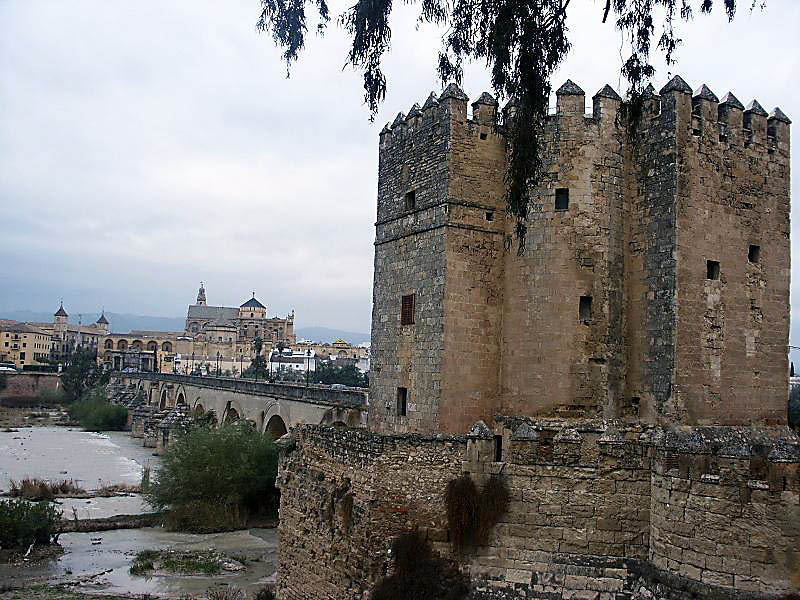
See tower, round above. A 10' square tower has walls 3' thick.
Tower,
square, 10' sq., 30' h.
COST:
600
DPV:
30
Tower,
square, 20' sq., 30' h.
COST:
900
DPV:
40
Tower,
square, 30' sq., 30' h.
COST:
1,200
DPV:
50
<placer image: for the final, make measurements>

A straight shaft generally
used as an escape route,
the underground tunnel is
assumed to be dug through soft earth and floored,
walled and roofed in rough
stone.
If it is dug through hard
earth the cost will increase by 100%.
If the tunnel is mined through
solid rock the cost will be 500% of the figure shown.
COST: 100 gp (5' w., 8'
h., 10' l.)
DPV:
This is a curved wall section,
typically hemispherical, built
into a curtain wall to provide
flanking fire. It has no battlement.
COST: 500 gp (5' w., 20'
h., 40' l.)
DPV: 40
This is a straight wall section
without battlements. If it is built
above 20' height it must
be thickened or supported by buttresses, pilasters,
etc.
COST: 1000 gp (10' w., 20'
h., 100' l.)
DPV: 20
**** This indicates the length of a curtain wall 10' thick in an area 10' wide by 10' high; if a breach, rather than a hole, is desired, the wall must be destroyed from top to bottom.
Window,
shuttered: A typical opening in a wall, it is covered by wooden
shutters of one inch thickness.
COST: 7 gp (2' w., 4' h.)
DPV: 4
Window,
shuttered & barred: This is a typical window protected by a
single bar with spurs to
either side ta prevent entrance through its
aperture. Bars on wider
windows can be multiples of the type above or
crossbar grilled.
COST: 10 gp (2' w., 4' h.)
DPV: 12
Q: How much does it
cost to build
Oriental structures? Where
can I
find building plans for
such structures?
A: The cost for an
Oriental-style structure
is the same as a comparable
structure in a
western campaign (see the
DMG,
page
107). Oriental “paper wall”
construction
costs about the same as
wooden construction
(85% -100% depending on
the quality
of the paper construction),
but is more
expensive to maintain (150%
of maintenance
costs). Try your local library
for
information on architecture;
ask the
librarian for books on any
of the following
subjects: castles, the Middle
Ages, medieval
warfare, medieval architecture,
Oriental
architecture, Japanese feudalism.
The
bibliography
on page 144 of Oriental
Adventures gives
a few specific titles to
ask about. See also the
two reference-book
articles on the Oriental
world in this issue
of DRAGON® Magazine.
<link to these articles>
(122.42)
